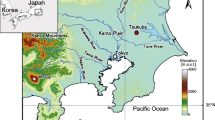Summary
Reliable assessments of the underground temperature are needed for construction projects like deep tunnels, shafts and storage facilities. In areas of pronounced topographic relief, special attention must be given to the influence of three-dimensional topography on the subsurface temperature field. Further parameters for the prediction include ground surface temperature, local heat flow density, geological factors (structure/schistosity, thermal conductivity, erosion rate, water circulation). A first prediction was attempted for the planned Gotthard railroad tunnel (NEAT). This tunnel will have a total length of 56 km with a maximum cover of 2500 m. The temperature predictions were calculated, based on the RIMINI topography array, for points at 1-km-intervals along the planned axis. Maximum temperature (conservative upper limit) is about 45°C; the error of the predicted temperatures could be, in view of the uncertainties involved, in general ca. ±5–10°C.
Since little is known at present about the deep water circulation system in the realm of the planned Gotthard tunnel, the prediction calculations assume heat transport by pure conduction. Significant subsurface water flow would mainly lead to the reduction of rock temperatures by cold infiltrations from the surface, as demonstrated by observations in the Simplon and Mont Blanc tunnels. In fact, the deviation of actual measurements (performed right behind the advancing face) from “conductive” previsions should be used as a predictive tool of large water flows which could be encountered during tunnel construction.
Similar content being viewed by others
References
Bodmer, Ph., Rybach, L. (1984): Geothermal map of Switzerland (Heat flow density). Beitr. Geol. Schweiz, Serie Geophysik Nr. 22, Kümmerly & Frey, Bern.
Bodmer, Ph., England, Ph. C., Kissling, E., Rybach, L. (1979): On the correction of subsurface temperature measurements for the effects of topographic relief. Part II: Application to temperature measurements in the Central Alps. In: Čermák, V., Rybach L. (eds.): Terrestrial heat flow in Europe. Springer, Berlin Heidelberg New York Tokyo, 78–87.
Bossolasco, M., Palau, C. (1967): Il flusso geotermico sotto il Monte Bianco. Geofis. Meteor. 14, 135–138.
Jamier, D. (1975): Etude de la fissuration, de l'hydrogéologie et de la géochimie des eaux profondes des massifs de L'Arpille et du Mont-Blanc. Thèse de Docteur ès-sciences, Université de Neuchatel.
Niethammer, G. (1910): Die Wärmeverteilung im Simplon. Eclogae Geol. Helv. 73, 96–120.
Powell, W. G., Chapman, D. S., Balling, N., Beck, A. E. (1988): Continental heat flow density. In: Haenel, R., Rybach, L., Stegena, L. (eds.): Handbook of terrestrial heat flow density determination, Kluwer Academic Publishers, Dordrecht, 167–222.
Rybach, L., Bodmer, Ph., Weber, R., England, Ph. C. (1982): Heat flow and heat generation in the new Gotthard tunnel, Swiss Alps. In: Haenel, R., Čermák, V. (eds.): Geothermics and geothermal energy. E. Schweizerbart'sche Verlagsbuchhandlung, Stuttgart, 63–69.
SMA (1989): Bodentemperaturen und Verdunstung 1951–1985. Klimatologie der Schweiz 28P, Schweizerische Meteorologische Anstalt, Zürich.
Author information
Authors and Affiliations
Rights and permissions
About this article
Cite this article
Rybach, L., Pfister, M. Temperature predictions and predictive temperatures in deep tunnels. Rock Mech Rock Engng 27, 77–88 (1994). https://doi.org/10.1007/BF01020206
Issue Date:
DOI: https://doi.org/10.1007/BF01020206




